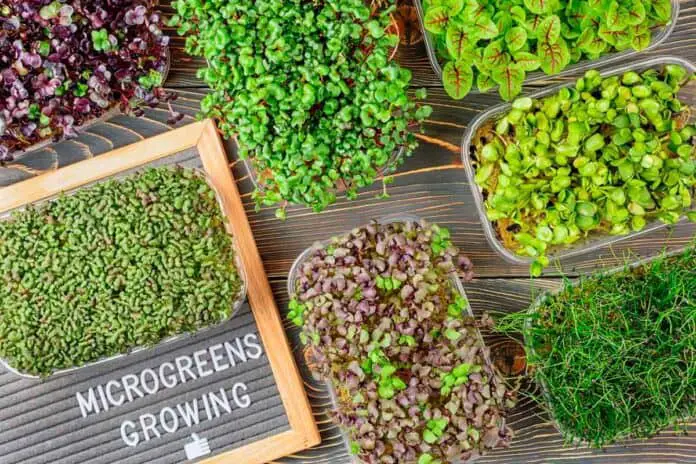What are the easiest microgreens to grow? New and skilled microgreen farmers look for new and easy additions to their farms. What better way to do that than to integrate easy-to-grow and good microgreens into their roster.
You’ll find that the easiest microgreens to grow are Radish, Broccoli, Arugula, Pea Shoots, Mustard microgreens, and Pak Choi. They perform well in their desired conditions and have few requirements, making them easy for beginners.
The growing of microgreens is highly dependent on the plant’s natural habitat. Farmers strive to replicate the plants’ original conditions into their growing environments. Some microgreens will flourish easily in these artificial conditions, while others will require more work to get the desired yield.
What Are The Easiest Microgreens To Grow?
Five factors go into determining the ease of growth of microgreens.
- Growing requirements
- The amount it yields
- Ease of harvest
- Possible challenges that farmers might face
- Ease of cleaning
Growing Requirements
Some microgreens require more complex requirements to ensure quality and bountiful yields. For example, Red Veined Sorrel is a popular microgreen, especially in the culinary industry. Chefs love to buy and use high-quality Red Veined Sorrel microgreens in their dishes because of their beauty. The growing results are bright-green leaves and vivid red stems that add color and a tangy flavor to any dish. The unfortunate side to Red Veined Sorrel is that it takes up to 30 days to mature. It’s considered long in the world of growing microgreens. As the growing period is long, there may be more challenges with mold, and damping off. It requires constant care to ensure that the plant does not bruise during the germination process.
Red Veined Sorrel is just one example of complicated microgreens. Celery is another microgreen that is delicate and requires around-the-clock care.
The Amount It Yields
Good and easy-to-grow produce will reflect in the amount it yields. The best microgreens will showcase high yields alongside less complex growing requirements. You want to start with a high-yield microgreen that will give you more than expected. Not only that, but it would be best if it didn’t require a lot of work and a lot of unanticipated costs.
Microgreen growing is unexpectedly cheap, but expenses pile up when you turn to more complex microgreens. As a home grower, you may not see the impact, but if you are growing commercially, the problem lies when the expected profits are lost due to failed yields.
Ease Of Harvest
Easy-to-grow microgreens also take top spots on the easy-to-harvest microgreens list. They do not require delicate handling when harvesting, and thus you have more room for error. Microgreens with longer stems are easier to harvest as you will not accidentally cut the leaves, or on the contrary, be too close to the soil. The latter to avoid having to remove any unwanted soil or dirt. Unfortunately, most microgreens won’t grow back after cutting, so you want success as you harvest.
Possible Challenges That Farmers Might Face
Every microgreen comes with its share of challenges. For example, growing mold, damping off, and uneven germinations. There are ways to combat these problems, and we have a full article about this topic: 8 Common Microgreen Problems And How To Fix Them
The 6 Easiest Microgreens To Grow And Why
Here are the six easiest microgreens and why you can get started on them right away.
1. Radish Microgreens
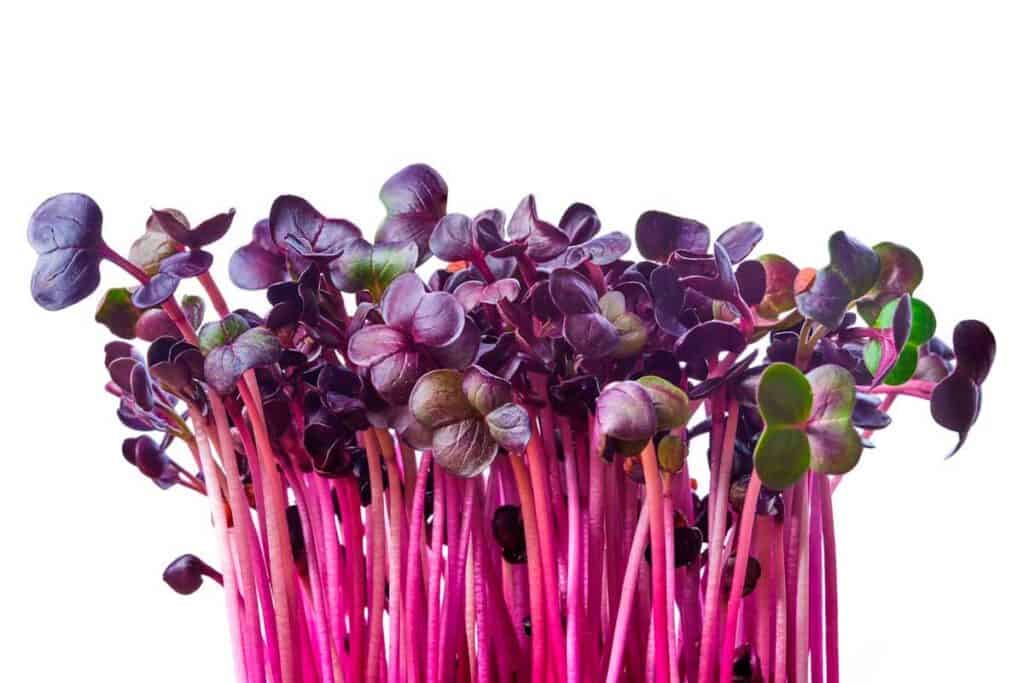
The Daikon, Rambo, and the China Rose are the most popular radish varieties to grow. They take around four days to germinate, and you have about a 3-day window to harvest them. All in all, you can estimate a week from planting to harvest.
Radish is a sturdy plant that farmers can always rest assured will perform. You can plant them in organic soil, coconut coir, or another growing medium. They need a few days in the dark to kick off germination, and then you bring them out in the light to flourish.
You can estimate getting 8-10 ounces per 10/20 tray in terms of yield. It’s pretty average in yield, but it’s better with an average result than a lower one.
2. Broccoli Microgreens
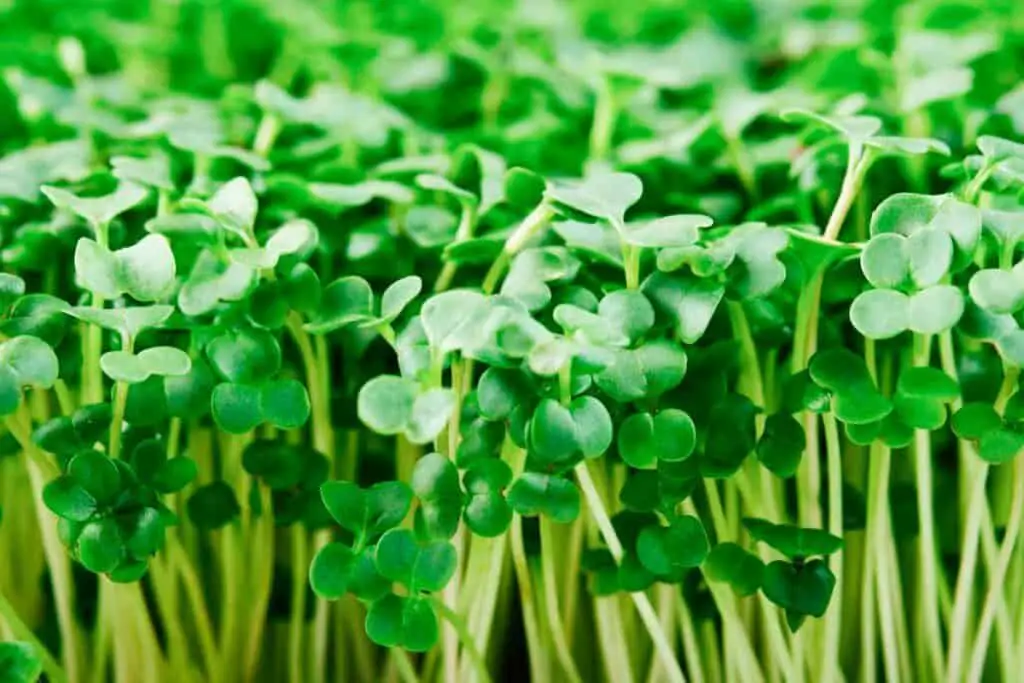
Experts consider Broccoli to be one of the easiest microgreens to grow. It takes around four days for the seeds to germinate, and after 9-14 days you are ready to harvest.
In terms of yield, broccoli is pretty average in yield. You expect
five to seven ounces per tray. However, if you sow the seeds more thickly, you can expect a higher output.
Similar to radish, it does not require any special treatment. It would be in your best interest to prevent it from growing until it matures; otherwise, it tends to get woody.
Broccoli is also easy to harvest, and storing them dry will make their shelf life longer. Experts have not found any possible challenges that come with growing broccoli. As an ancestor to the European wild cabbage, broccoli will not disappoint and ranks pretty high on the list of the easiest microgreens to grow.
3. Arugula Microgreens
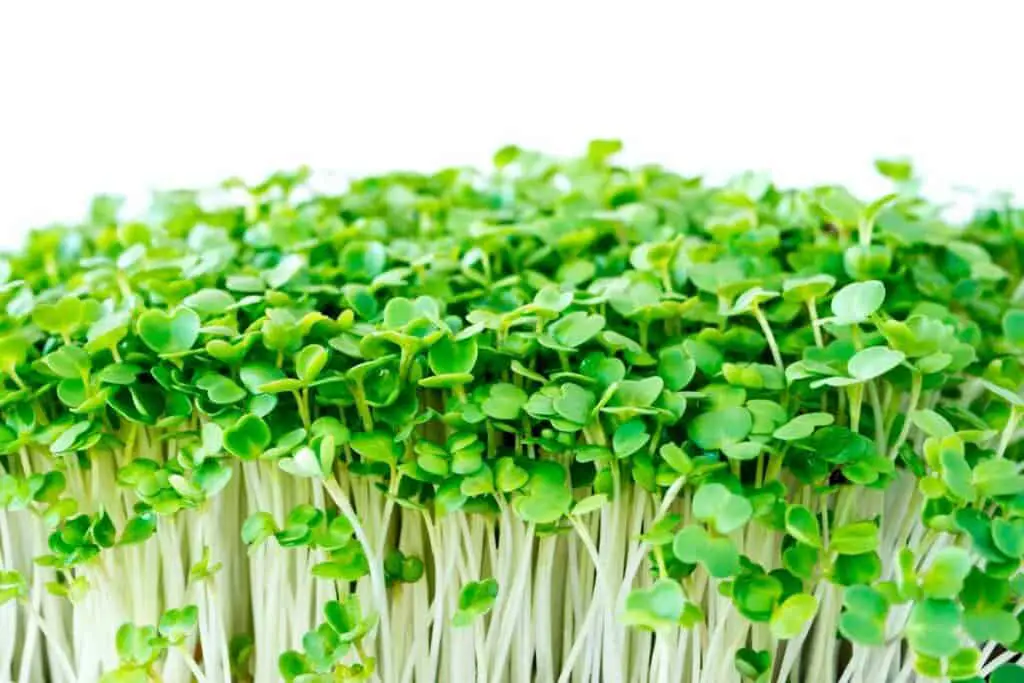
The standard Arugula is the favorite variety to grow. It takes around five days to germinate, and after 10 days you are ready to harvest them.
Arugula is one of the easiest microgreens to grow and one of the fastest.
Arugula is below average in terms of yield. You can expect four to six ounces per 10/20 tray; it’s a bit lower compared to other microgreens on this list.
One possible challenge you might face is that the seeds are mucilaginous which means they can stick to the top tray if you are using one of those. Another thing is the thinness of the stem. You should gently water the plant because the thin stem can break during watering. Fortunately, Arugula is beginner-friendly, and pretty much anyone can grow it if they have an adequate setup.
4. Pea Microgreens
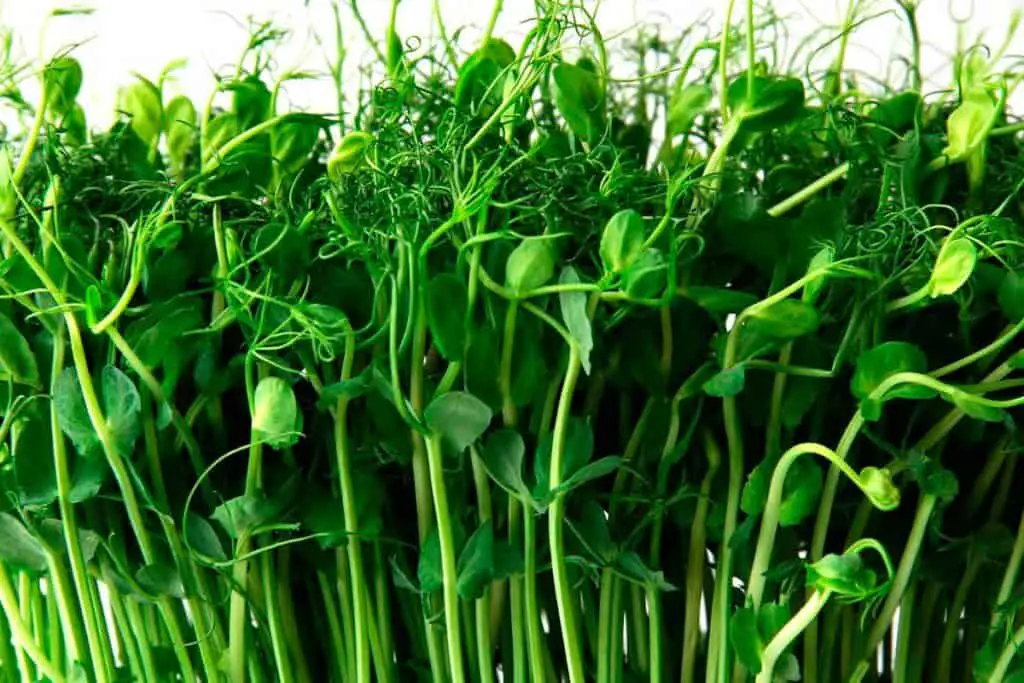
Pea microgreens are also easy to grow. It takes around four days for them to germinate, and after two weeks they are ready to be harvested.
Pea microgreens seeds are bigger than most microgreens seeds and can favor from being soaked before planting. You should expect a higher yield with pea shoots. On average, you can expect eight to twelve ounces per harvest. In comparison to other microgreens, it’s pretty high.
Not only that, but pea shoots are extremely easy to harvest with their long stems.
5. Mustard Microgreens
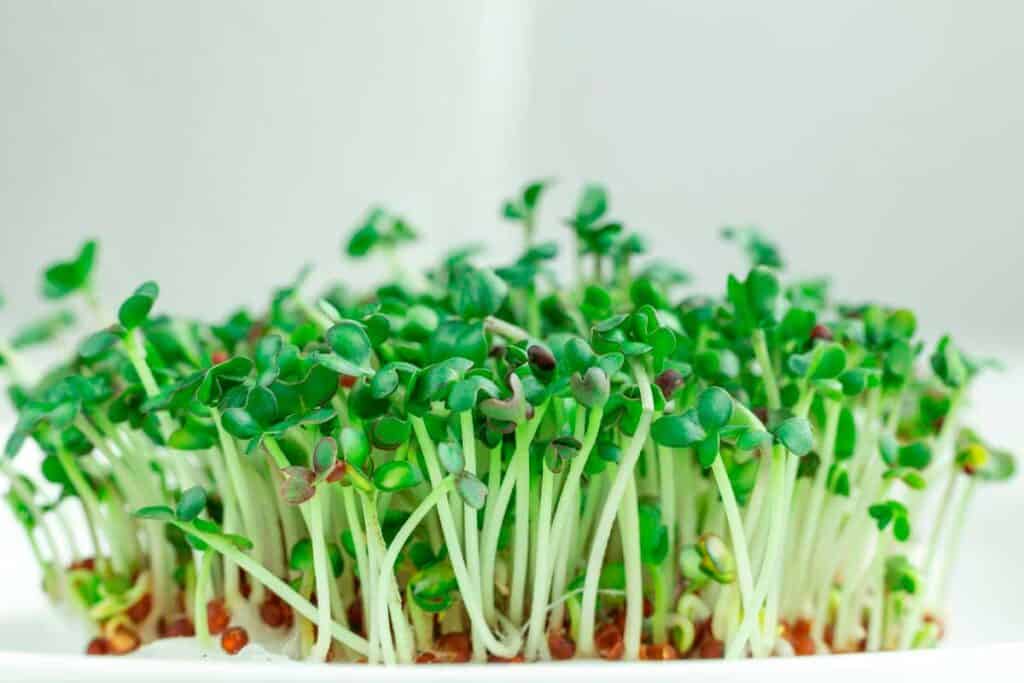
Experts highly recommend Red Giant, Ruby Streaks, and Garnet Red varieties. They can take about 3-4 days to germinate, which is pretty quick similar to other microgreens like peas.
You can also expect an average yield of between four to eight ounces. However, these numbers vary according to the variant you are planting. The Ruby Streaks variant is known to produce the highest output.
The highlight of Mustard microgreens is that it’s easy to get the true leaves once germination starts. Furthermore, they are easy to harvest.
One possible challenge is that if you leave the microgreens to grow for too long, the plant’s embryo (cotyledon) will start to turn yellow.
6. Pak Choi
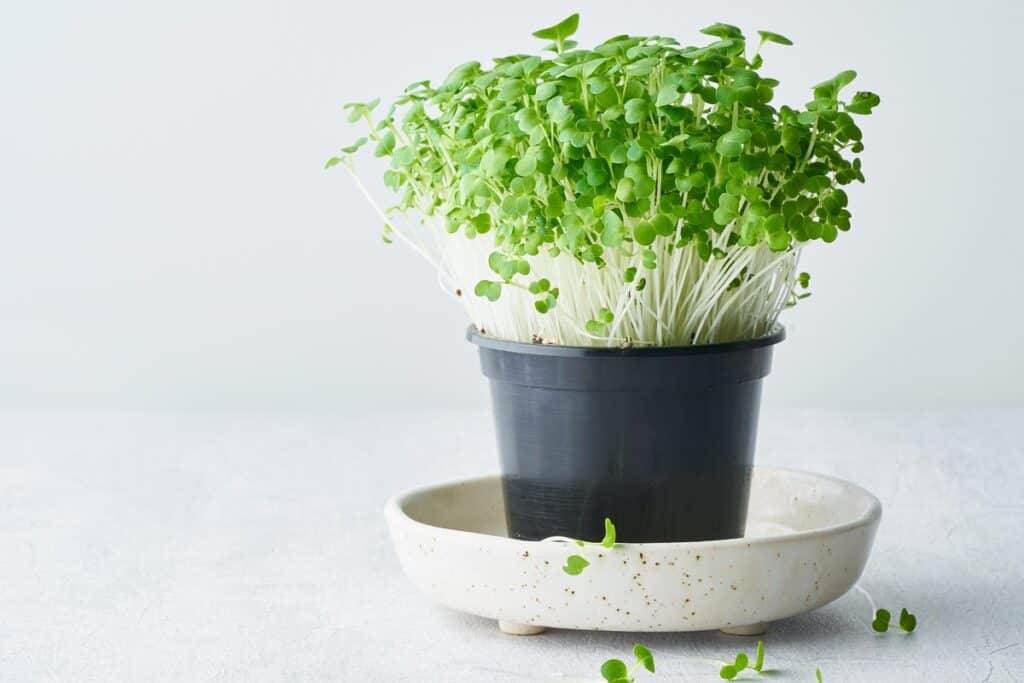
Lastly is Pak Choi. This microgreen also falls in the easy scale of growth. Fortunately, it is easy to harvest and has minimum possible challenges for farmers.
Not only that, Pak Choi results in a high yield. You can expect eight to ten ounces per tray, ranking it higher on the list. Lastly, Pak Choi requires around four days to germinate and can be harvested after 10 days.
Pak Choi is easy to grow because it doesn’t need complex requirements. You can also rest assured that you will not face any unwanted challenges if you grow it correctly throughout the germination process. The best part is that Pak Choi is beginner-friendly, and the results are rewarding.
What Are The Fastest Growing Microgreens?
Microgreens, on average, take about four days to germinate. However, some microgreens take less, making them extremely fast. Although fast does not always mean that they are easy to grow.
Here are the fastest-growing microgreens.
| Microgreen | Growing period (in days) |
|---|---|
| Amaranth | 14-18 days |
| Arugula | 10-14 days |
| Cress | 10-12 days |
Some honorable mentions in this list because of their popularity in the microgreen industry are
- Pea shoots (9-14 days)
- Pak Choi (10-12 days)
- Mustard (8-12 days)
On the other hand, you have microgreens that take longer to grow. Here are some of the slowest growing microgreens in the market:
- Celery (21 – 28 days)
- Chard (50-55 days)
- Cilantro (12-15+ days)
The Cheapest Microgreens To Grow
In general, starting a microgreen business is pretty cheap. You can begin a microgreen business with low startup costs. It’s one of the reasons why microgreens are absurdly popular. You require small amounts of capital to start, and you can get high amounts of profit in return.
In general, to start your microgreens farm, you will require the following materials:
- Trays (top and bottom)
- Soil or another growing medium such as coconut coir
- Seeds
- Watering tools
- Storage containers
- Scale
- Scissors or sharp knife
If you’re starting with the easiest microgreens to grow, you will need only the available materials to get you started. You could say that the easiest microgreens to grow are, in turn, the cheapest microgreens to grow.
They do not require special tools like a pH meter or heat mats; those are additional costs, thus making them the cheapest of the bunch.
The Most Popular Microgreens For Chefs
Restaurants are the most popular target markets for microgreen businesses. Getting a contract with a restaurant can herald a new venture for local microgreen businesses.
To get a supplier contract with a restaurant, you must know which microgreens are popular among chefs.
Here are some of the favorite microgreens for chefs:
- Basil (for its potent flavor)
- Pea (for its sweet and fresh taste)
- Purple cabbage (for its mild cabbage flavor)
- Arugula (it provides a sharp and spicy taste)
- Sunflower (sunflower, in general, is a popular microgreen)
What Did This Article Yield?
Microgreens are slowly increasing in popularity. Experts estimate that the microgreen industry will have a compound annual growth rate of 17% between 2020 – 2025. Fortunately, for anybody interested in getting started, radish, pea, Arugula, etc., are among the easiest microgreens to grow and help you get started in the industry.
Microgreens are a great business idea, and when done right, the results promise increased profits.


